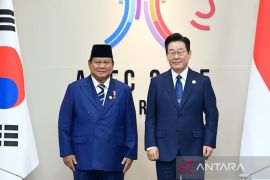Moving up the value chain will make the region more resilient and increase economic gains, as noted by the APEC Policy Support Unit in a statement received here on Wednesday.
The fourth industrial revolution refers to the integration of digital technologies in different sectors, with inventions from a wide range of fields, such as information technology hardware and software, connectivity, data management, user interfaces, power supply, as well as consumer goods, smart homes, vehicles, and healthcare applications.
"Participating in global value chains is a common avenue for economies to join the global production and the innovation ecosystem. However, we also know that the revenue generated from each stage of the value chain is not equally distributed," Akhmad Bayhaqi, a senior analyst with the Policy Support Unit, remarked.
Bayhaqi explained the concept of the "smiling curve" in value chains, wherein the two ends of the smile -- one end closer to the producer and the other closer to the consumer -- have higher gain in terms of value added as compared to the middle point.
"This middle point is the labor-intensive manufacturing stage, which generally adds less relative value," he explained.
"In order to increase revenue and gains from participating in global value chains, member economies could move their position either upstream towards research and development activities or downstream towards branding and marketing activities," he remarked.
That is where the development and adoption of fourth industrial revolution technologies play a role, according to the policy brief. The level of technological advancement of an economy could influence its position in global value chains.
Investing in research and development as well as labor upskilling, for instance, can help member economies leapfrog to higher stages, while a more traditional approach, such as specialization, could help member economies incrementally build their technology and production capabilities as they move up value chains.
In 2019, the APEC region contributed around 80 percent, or US$699 billion, of global exports of fourth industrial revolution products and 63 percent, or US$533 billion, of their global imports.
China was the leading global exporter, followed by Chinese Taipei, Japan, Korea, and Mexico. On the import side, the United States and China were the two main contributors, importing 24 percent and 21 percent, respectively.
The policy brief also measures how innovative APEC economies are in the fourth industrial revolution field by assessing the number of patent application collections covering similar technical content.
In the last two decades, the APEC region has recorded a six-fold increase in patent families, from just over nine thousand in 2000, to nearly 57 thousand in 2019.
Those were mainly for connectivity, home, consumer goods, as well as information technology hardware and software.
Economies that are most active in patenting, such as Canada, China, Japan, Korea, Chinese Taipei, and the United States, also show high patent content embedded in their value chains.
"Global value chains, as a form of trade network between multinational corporations and their globally dispersed suppliers, can be channels for the transfer of knowledge, know-how, and innovation," Bayhaqi explained.
"Advanced digital production technologies can bring about integration and upgrading benefits as well as opportunities, such as improving production efficiency using big data analytics," he concluded.
The advantage of adopting and investing in fourth industrial revolution technologies go beyond adding revenue and gains, according to the report.
It is a forward-looking strategy that allows member economies to continue their innovative growth path, as mandated in the APEC Putrajaya Vision.
Meanwhile, the successful adoption of these technologies is dependent on enabling factors, such as closing the digital skills gap through digital literacy training; upskilling for local workforces; and knowledge transfers through foreign direct investment in prioritized sectors.
Related news: APEC boosts SMEs' competitiveness through health ethics pacts
Related news: APEC ministers aim for recovery, resilience of small businesses
Related news: Research addressing postnatal depression wins APEC prize
Reporter: Yuni Arisandy Sinaga
Editor: Sri Haryati
Copyright © ANTARA 2022











